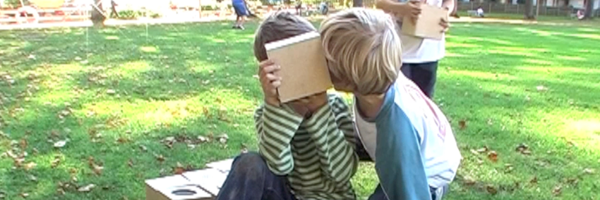7. October 2010
 The results of the test with the objects could be seen from two different angles. First there are the objects themselves, which were used and explored by the children. This insights of how the children used the objects gave me insights about the objects themselves. Second there where actions around the objects which aren't obvious at first sight, but they gave me clear insights about the social behavior of the children.
The results of the test with the objects could be seen from two different angles. First there are the objects themselves, which were used and explored by the children. This insights of how the children used the objects gave me insights about the objects themselves. Second there where actions around the objects which aren't obvious at first sight, but they gave me clear insights about the social behavior of the children.
Objects: _Simple and obvious form guides to immediate detection of the functionality. _Metaphorical connections (e.g. sponge) where naturally for the children. _Common forms and signs are available for the children (e.g. loudspeaker matrix). _The cover plates of the cubes could be used to mix the functionalities of the objects. _Open objects support exploration of one child as well as collaborative explortion. _Obvious and banal objects evoke the childrens fantasy and creativity. _If the functionality doesn‘t become obvious, the object isn‘t interesting. _A spinning element is a lot of fun, different materials can be integrated into play. _Light is a very important feedback for them.
Actions: _The first reaction was questions about the purpose of the objects. _Approach is initiated by firstly looking from far away. _The first inspection of the objects is visual. _The second step of approaching the objects is through tactile exploration. _Complete engagement with the cubes (visual, tactile, sonic, sensorimotor) _Children ask if they don't know what to do. _One object is completely explored before the child focuses another. _There are connections to known behaviors. _Imitation among the kids is a common behavior. _There is also imitation of the behaviors of the objects. _Children are supporting each other by giving ideas. _Through collaboration new ideas evolve. _Alternative Use Cases were considered. _Small children use the objects without thinking of the functionalities.
To make the results more clear, I've created a map on which the objects, the childrens ideas and the actions are arranged in a timeline. Looking at this timeline it becomes clear, that children don't need much time (approx. 5min) to explore the basic functionality of the objects. After this first approach towards the objects the children began to utilize the objects according to their own ideas. They have tried to build machines by connecting the objects together or they collaborated to come up with new and unusual ideas.
 Basically one can say, that children have ideas that seem to be not logical - in a sense how we will describe "logic". Often the resulting ideas were banal and very simple. With the design of interactive objects we could support this approach of the children by making a variety of connections possible and don't complicate the interactions with the objects.
Another interesting insight was the point where a younger child (approx 3 years) joined the other children. She wasn't interested in the affordances of the objects - not even the most obvious ones as for example the "Crank" cube. She only used the objects to arrange them in a line or to build a tower out of the boxes. The boxes were used as if they only are toy bricks.
Basically one can say, that children have ideas that seem to be not logical - in a sense how we will describe "logic". Often the resulting ideas were banal and very simple. With the design of interactive objects we could support this approach of the children by making a variety of connections possible and don't complicate the interactions with the objects.
Another interesting insight was the point where a younger child (approx 3 years) joined the other children. She wasn't interested in the affordances of the objects - not even the most obvious ones as for example the "Crank" cube. She only used the objects to arrange them in a line or to build a tower out of the boxes. The boxes were used as if they only are toy bricks.